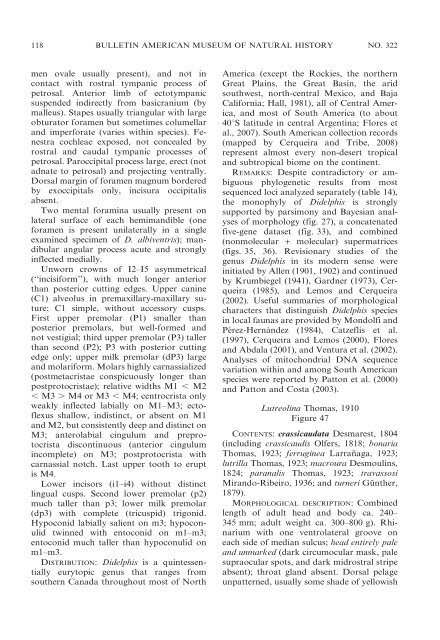phylogenetic relationships and classification of didelphid marsupials ...
phylogenetic relationships and classification of didelphid marsupials ...
phylogenetic relationships and classification of didelphid marsupials ...
You also want an ePaper? Increase the reach of your titles
YUMPU automatically turns print PDFs into web optimized ePapers that Google loves.
118 BULLETIN AMERICAN MUSEUM OF NATURAL HISTORY NO. 322<br />
men ovale usually present), <strong>and</strong> not in<br />
contact with rostral tympanic process <strong>of</strong><br />
petrosal. Anterior limb <strong>of</strong> ectotympanic<br />
suspended indirectly from basicranium (by<br />
malleus). Stapes usually triangular with large<br />
obturator foramen but sometimes columellar<br />
<strong>and</strong> imperforate (varies within species). Fenestra<br />
cochleae exposed, not concealed by<br />
rostral <strong>and</strong> caudal tympanic processes <strong>of</strong><br />
petrosal. Paroccipital process large, erect (not<br />
adnate to petrosal) <strong>and</strong> projecting ventrally.<br />
Dorsal margin <strong>of</strong> foramen magnum bordered<br />
by exoccipitals only, incisura occipitalis<br />
absent.<br />
Two mental foramina usually present on<br />
lateral surface <strong>of</strong> each hemim<strong>and</strong>ible (one<br />
foramen is present unilaterally in a single<br />
examined specimen <strong>of</strong> D. albiventris); m<strong>and</strong>ibular<br />
angular process acute <strong>and</strong> strongly<br />
inflected medially.<br />
Unworn crowns <strong>of</strong> I2–I5 asymmetrical<br />
(‘‘incisiform’’), with much longer anterior<br />
than posterior cutting edges. Upper canine<br />
(C1) alveolus in premaxillary-maxillary suture;<br />
C1 simple, without accessory cusps.<br />
First upper premolar (P1) smaller than<br />
posterior premolars, but well-formed <strong>and</strong><br />
not vestigial; third upper premolar (P3) taller<br />
than second (P2); P3 with posterior cutting<br />
edge only; upper milk premolar (dP3) large<br />
<strong>and</strong> molariform. Molars highly carnassialized<br />
(postmetacristae conspicuously longer than<br />
postprotocristae); relative widths M1 , M2<br />
, M3 . M4 or M3 , M4; centrocrista only<br />
weakly inflected labially on M1–M3; ect<strong>of</strong>lexus<br />
shallow, indistinct, or absent on M1<br />
<strong>and</strong> M2, but consistently deep <strong>and</strong> distinct on<br />
M3; anterolabial cingulum <strong>and</strong> preprotocrista<br />
discontinuous (anterior cingulum<br />
incomplete) on M3; postprotocrista with<br />
carnassial notch. Last upper tooth to erupt<br />
is M4.<br />
Lower incisors (i1–i4) without distinct<br />
lingual cusps. Second lower premolar (p2)<br />
much taller than p3; lower milk premolar<br />
(dp3) with complete (tricuspid) trigonid.<br />
Hypoconid labially salient on m3; hypoconulid<br />
twinned with entoconid on m1–m3;<br />
entoconid much taller than hypoconulid on<br />
m1–m3.<br />
DISTRIBUTION: Didelphis is a quintessentially<br />
eurytopic genus that ranges from<br />
southern Canada throughout most <strong>of</strong> North<br />
America (except the Rockies, the northern<br />
Great Plains, the Great Basin, the arid<br />
southwest, north-central Mexico, <strong>and</strong> Baja<br />
California; Hall, 1981), all <strong>of</strong> Central America,<br />
<strong>and</strong> most <strong>of</strong> South America (to about<br />
40uS latitude in central Argentina; Flores et<br />
al., 2007). South American collection records<br />
(mapped by Cerqueira <strong>and</strong> Tribe, 2008)<br />
represent almost every non-desert tropical<br />
<strong>and</strong> subtropical biome on the continent.<br />
REMARKS: Despite contradictory or ambiguous<br />
<strong>phylogenetic</strong> results from most<br />
sequenced loci analyzed separately (table 14),<br />
the monophyly <strong>of</strong> Didelphis is strongly<br />
supported by parsimony <strong>and</strong> Bayesian analyses<br />
<strong>of</strong> morphology (fig. 27), a concatenated<br />
five-gene dataset (fig. 33), <strong>and</strong> combined<br />
(nonmolecular + molecular) supermatrices<br />
(figs. 35, 36). Revisionary studies <strong>of</strong> the<br />
genus Didelphis in its modern sense were<br />
initiated by Allen (1901, 1902) <strong>and</strong> continued<br />
by Krumbiegel (1941), Gardner (1973), Cerqueira<br />
(1985), <strong>and</strong> Lemos <strong>and</strong> Cerqueira<br />
(2002). Useful summaries <strong>of</strong> morphological<br />
characters that distinguish Didelphis species<br />
in local faunas are provided by Mondolfi <strong>and</strong><br />
Pérez-Hernández (1984), Catzeflis et al.<br />
(1997), Cerqueira <strong>and</strong> Lemos (2000), Flores<br />
<strong>and</strong> Abdala (2001), <strong>and</strong> Ventura et al. (2002).<br />
Analyses <strong>of</strong> mitochondrial DNA sequence<br />
variation within <strong>and</strong> among South American<br />
species were reported by Patton et al. (2000)<br />
<strong>and</strong> Patton <strong>and</strong> Costa (2003).<br />
Lutreolina Thomas, 1910<br />
Figure 47<br />
CONTENTS: crassicaudata Desmarest, 1804<br />
(including crassicaudis Olfers, 1818; bonaria<br />
Thomas, 1923; ferruginea Larrañaga, 1923;<br />
lutrilla Thomas, 1923; macroura Desmoulins,<br />
1824; paranalis Thomas, 1923; travassosi<br />
Mir<strong>and</strong>o-Ribeiro, 1936; <strong>and</strong> turneri Günther,<br />
1879).<br />
MORPHOLOGICAL DESCRIPTION: Combined<br />
length <strong>of</strong> adult head <strong>and</strong> body ca. 240–<br />
345 mm; adult weight ca. 300–800 g). Rhinarium<br />
with one ventrolateral groove on<br />
each side <strong>of</strong> median sulcus; head entirely pale<br />
<strong>and</strong> unmarked (dark circumocular mask, pale<br />
supraocular spots, <strong>and</strong> dark midrostral stripe<br />
absent); throat gl<strong>and</strong> absent. Dorsal pelage<br />
unpatterned, usually some shade <strong>of</strong> yellowish

















